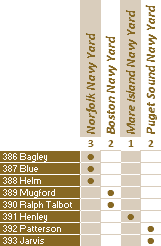
Length: 341' 3-5/8" overall; 334' design waterline.1
Beam: 34' 11-3/4" molded maximum; 35' 5-1/4" outside of plating at design waterline.1
Freeboard: 21' 5" at bow; 10' 7-1/2" at stern.1
Displacement: 1,500 long tons design; 1,715 or 1,725 long tons to design waterline.1
Draft: 11' 5-1/2" mean; 13' 2-1/4" full load.3
Propulsion machinery: 4 x navy yard and Babcock & Wilcox boilers; 465 psi, 645° F.; navy yard and GE geared turbines; 50,000 shp; 2 shafts.3
Designed speed: 36.5 knots.2
Fuel bunkerage: 501.4 tons full load.1
Endurance: 7,800 nm at 12 knots.3
Designed complement: 13 officers; 193 enlisted.3
Torpedo battery: Sixteen 21-inch trainable torpedo tubes: two quadruple wing mounts on each side of the main deck abaft the stack.
Main gun battery: 4 x dual purpose 5-inch/38 caliber guns: 2 forward in enclosed base ring mounts; 2 aft in open pedestal mounts.
Anti-aircraft battery: 1937: 4 x .50 cal. machine guns; 1945: 2 x 40mm Bofors in one twin mount; 6 x 20mm Oerlikon in single mounts.

All eight ships were commissioned between June and October 1937 and retained their full compliment of torpedo tubes throughout their careers. Survivors received increased anti-aircraft armament (including one superimposed 40mm twin aft—see photo of Mugford, below) as World War II progressed.
On 7 December 1941 when the Japanese attacked Pearl Harbor, all eight Bagleys were present as Destroyer Squadron 4 with Selfridge as flagship. After operating in carrier screens during the Pacific island raids of early 1942, they were transferred to Australia in June and participated in the seizure of Guadalcanal in August. In the thick of the action there, Jarvis was lost with all hands and Blue was scuttled to avoid capture after being surprised and torpedoed by an enemy destroyer, while Mugford, Patterson, Helm and Ralph Talbot were damaged.

Overhead view of Mugford.
An enemy submarine sank Henley off New Guinea in 1943 and an enemy plane crashed Mugford off Leyte in December 1944, putting her out of action for six months. Operating thereafter as DesRon 6, the other four all earned 11 or more stars, with Ralph Talbot sustaining a kamikaze hit off Okinawa. Bagley accepted the surrender of Japanese forces on Marcus Island. Mugford and Ralph Talbot, still in commission, were targets at Bikini atomic bomb tests in 1946; contaminated but not sunk, they were scuttled in deep water off Kwajalein 1948. The other three were decommissioned in 1945 and scrapped in 1947.
1 Bureau of Construction and Repair’s General Information book for the Bagley class.
2 Bauer and Roberts.
3 Friedman.